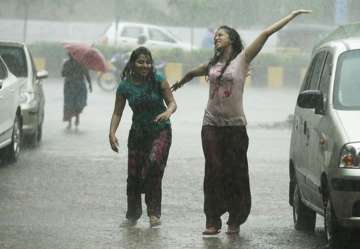IMD forecasts 'normal monsoon' for all of India, except east and north-east
The monthly rainfall over the country as whole is likely to be 101 per cent of its Long Period Average (LPA) during July, and 94 per cent of LPA during August -- both with a model error of plus or minus 9 per cent.

The entire country is expected to receive normal monsoon this year, except the east and northeast India, which is likely to witness "below normal" rainfall, the Met department said today.
The MeT has kept its prediction of "normal" monsoon unchanged in its second stage long range forecast.
The monthly rainfall over the country as whole is likely to be 101 per cent of its Long Period Average (LPA) during July, and 94 per cent of LPA during August -- both with a model error of plus or minus 9 per cent.
Notably, anything between 90-96 per cent of the the LPA is considered as "below normal while rainfall in the range of 96-104 per cent of the LPA is considered as "normal".
Also, rainfall is considered as "deficient" if it ranges below 90 per cent of the LPA and "above normal" if it falls between 104 to 110 per cent of the LPA.
Above 110 per cent of the LPA is considered as "excess" rainfall.
"Rainfall over the country as a whole for the 2018 southwest monsoon season (June to September) is most likely to be normal (96 to 104 per cent of LPA). Quantitatively, the monsoon season (June to September) rainfall for the country as a whole is likely to be 97 per cent of the LPA with a model error of plus or minus 4 per cent," the IMD said.
There is also a 43 per cent probability of normal monsoon, it added.
On the progress of the monsoon, it said that the conditions are favourable for its further advancement into some parts of north-eastern states during next 48 hours.
It added that the conditions are also likely to become favourable for further advance of the southwest monsoon into some more parts of south peninsula around June 3.
"Rainfall activity is likely to increase over parts of Maharashtra and Goa states from June 6," the IMD said.
Importantly, in the first long range forecast last month, the IMD had predicted that the country is likely to get 97 per cent of the LPA (normal monsoon) with an error margin of plus or minus five per cent.
"Region wise, the seasonal rainfall is likely to be 100 per cent of LPA over northwest India (comprising states of Rajasthan, Uttar Pradesh, Jammu and Kashmir, Himachal Pradesh, Punjab, Haryana, Delhi) 99 per cent of LPA over Central India, 95 per cent of LPA over South Peninsula and 93 per cent of LPA over east and northeast India (West Bengal, Jharkhand, Bihar and the northeastern states) all with a model error of plus or minus 8 per cent," it added.
According to Skymet, a private weather forecasting agency, June is likely to get 111 per cent of rainfall, which falls in the "excess" category. However, July and August are expected to witness 97 and 96 per cent of the LPA respectively, which comes under the "normal" category.
Further, on the monsoon activity, as per the Skymet, it is expected to revive in September and is likely to record rainfall of 101 per cent of the LPA.
Meanwhile, monsoon arrived in Kerala three days in advance, with rains lashing several parts of state on Tuesday.
Several parts of Kerala witnessed moderate monsoon rains on the first day of monsoon marking the commencement of the four-month long rainy season in the country.
June 1 is the official onset date for arrival of monsoon in the country and it takes more than a month-and-half to cover the entire country.
The IMD has made a forecast of "normal" rainfall this season.
Skymet, a private weather forecasting agency and a rival of the IMD, had said that the monsoon made its arrival in Kerala yesterday.
According to the IMD, if after May 10, 60 per cent of the available 14 stations --Minicoy, Amini, Thiruvananthapuram, Punalur, Kollam, Allapuzha, Kottayam, Kochi, Thrissur, Kozhikode, Thalassery, Kannur, Kudulu and Mangalore -- report 2.5 mm or more rainfall for two consecutive days, the onset of monsoon over Kerala can be declared on the second day. This is one of the main parameters for declaring the arrival of monsoon.
(With PTI inputs)